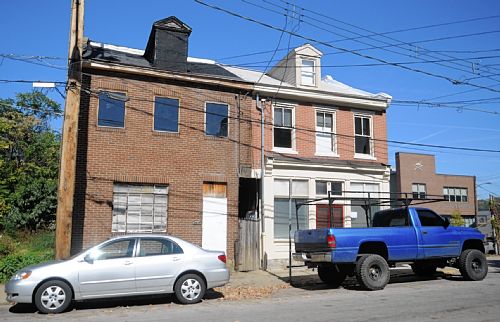
A Tale of Two Houses on the South Side
Among Pittsburgh’s many stories, one plays out in every neighborhood and is always sad.
It’s the tale of two owners and two buildings stuck together, one an asset to the neighborhood, the other a worry and a shame.
Pick a neighborhood, pick a street and you are likely to find two adjacent addresses that speak to the larger struggle between progress and abandonment.
The example at 1109-1111 Bingham St. on the South Side centers on a party wall that separates one man’s investment from a building condemned three years ago.
Bingham is one block north of and parallel to East Carson Street and is included in the East Carson historic district, which is why Tom Gigliotti and Tom Chajkowski appeared last week before the Historic Review Commission, whose agenda included Mr. Chajkowski’s property.
The commission voted to spare it for another 30 days; Mr. Chajkowski said he will produce an architect’s plan next month.
“It does need extensive work,” he told the panel, “but it can be done. It’s one of four houses left on that historic block.”
The next morning, on the sidewalk outside his commercial photography studio, Tom Gigliotti, the neighbor, said, “We’re back at square one, where we were three years ago.”
He said he does not feel antagonistic and even has some sympathies; the two men talk. But he’s clearly frustrated.
He bought his property in 1995 for $65,000 after having rented it for 10 years. It was “pretty run-down,” he said. “I don’t know how much I’ve put into it. Probably more than I could ever get out of it. A lot of blood and sweat.”
The two-story studio was completely remodeled, with hardwood flooring, a restored tin-stamped ceiling, a modern kitchen, skylights and a deck.
Because of the party wall, the adjacent building poses a threat to his building, both as is and in the case of demolition. It wasn’t such a threat 15 years ago, he said.
“Fifteen years now it’s been vacant, and there’s legally nothing I can do until it affects my building. It’s about to that point now.”
In 2005, Mr. Chajkowski was served notice for broken windows and a rotted rooftop deck. The city’s demolition manager, Paul Loy, told the commission that in November 2007, the property was condemned. The city and the owner were in court several times, he said.
In 2008, “he got a building permit, but he didn’t do anything, so it was revoked.
“This neighbor [Mr. Gigliotti] has tried to get it, but this owner is in dream world.”
Mr. Gigliotti said he has offered to buy the property but that the price has been impractically high.
In appealing to the commission for more time, Mr. Chajkowski lamented that he has had building permits revoked and been unable to get an architect, either because they are too busy or too expensive.
He could not be reached for further comment.
“I lived in the building for 20 years,” he told the commission. “My grandmother raised her kids around the corner” on 11th Street. This was his family’s first neighborhood in America, for 100 years, he said.
He said he thinks he can save his building. “I have a construction line of credit available and room on my credit card,” he said. “The taxes are paid and the building is secure.”
Mr. Gigliotti said he has heard this before and wonders how a person who claims such long ties to the neighborhood can allow his property to degrade it.
In the back courtyard that separates the two buildings, the air reeks of mildew. A door was ajar the other day. Through the crack, the interior contents resembled a dump and dampened remnants of a multi-family rummage sale.
The building has no downspouts or gutters. Mr. Gigliotti said his basement collects water when it rains. “It’s undermining my foundation.
“If this property costs him too much, I wish he would slap a ‘for sale’ sign on it so someone might save it.”

